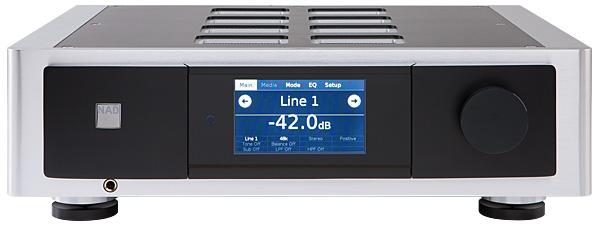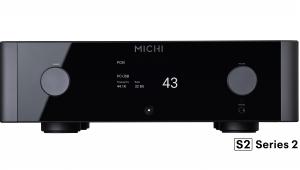NAD M32 digital amplifier

 A reversal of digital direction marks out this hi-tech integrated amp from the Masters Series, so can NAD's innovative thinking make the M32 stand out from the crowd?
A reversal of digital direction marks out this hi-tech integrated amp from the Masters Series, so can NAD's innovative thinking make the M32 stand out from the crowd?
Just in case you can't work out what the £3499 NAD M32 actually is – straight from the box only a volume control sets it apart from the company's similarly styled M22 v2 power amp – the front panel tells you, at least when powered up, that this is a 'Direct Digital DAC/Amplifier'. Of course, even powering it up may be a challenge for those for whom 'RTFM' is a sign of weakness. After a bit of stabbing of the NAD logo, which glows amber in standby, suggesting it might do something, they'll probably eventually alight on the little touch pad top and centre above the display. Brush this and the amp gets ready to do its stuff, at which point the amber surround on the logo turns white and you're in business.
Looks Deceive!
Given the simplicity of the fascia – apart from the illuminated logo, display and one knob, there's just a headphone socket, driven from its own discrete amp – you might expect that single control to be some kind of cunning multifunctional 'twist and push' device. Nothing of the kind: it's simply a volume knob and no more, with all the other functions handled by the touch-panel display, or the remote handset.
However, don't let that apparently basic first impression fool you, for this is no stripped-out minimalist amp, but rather a very complex and capable device, with a wide range of settings. It just happens to look very like the simpler M22 power amp, from the black finish and aluminium construction to the octet of deep-set ventilation grilles in the thick top panel.

There's something very right about the way NAD's Masters Series is styled, managing to look purposeful and weighty without straying into the overt machismo of some rival designs. Editor PM reveals the story behind NAD's digital amplification right here. So the amp we have here uses the company's own DirectDigital technology, which it shorthands as 'A DAC that amplifies', and describes more fully as 'a super DAC that can directly drive loudspeakers with very high power levels and yet still have the precision of the very finest line-level DACs'.
What that means – and here I must suggest that the analogue purists among you have the smelling-salts to hand, just in case – is that while the M32 has both digital and analogue inputs, the latter are digitised right at the outset. A set-up menu option allows sample rate selection for the analogue-to-digital converter (ADC), with a choice of 48kHz, 96kHz or 192kHz.
After some experimentation with the settings for this element, I'd probably settle for the highest one whenever possible, as it seems to give the crispest, cleanest treble, and the best sense of air in the sound – this being especially noticeable with church acoustics and the like. However, it should be noted that the sample rate options are only available on the Line 1 and 2 inputs, as the built-in MM phono stage is fixed.
Modular Options
Talking of inputs, the M32 has those three analogue inputs, plus two coaxial, two optical and a single AES/EBU digital input, along with an asynchronous USB Type B socket for computer connection. There's also a USB Type A, but that's provided only for service purposes, including firmware updates. And as well as two sets of speaker outputs, the amp also has a pair of analogue outs, configurable as full-range preamp or a filtered (20Hz-400Hz) subwoofer feed.
That's just one element of a very flexible menu system, even extending to setting the whole amp to a predetermined fixed gain, allowing it to function as a power amp should you require that at some point. The line inputs can be set to variable or fixed level – the latter handy for AV integration, for example – and have their gain adjusted by up to 12dB to equalise levels between sources, and it's also possible to rename the various inputs, and even switch off those not in use.
Back up one level from individual sources to global settings, and the amp has defeatable tone and balance controls, a selector for speaker impedance compensation – an attempt to yield the flattest 'real world' response – and even a mono switch, polarity inversion and the ability to switch speakers left to right should you stumble across a recording with its channels reversed!
So the M32 is a highly flexible amp by any standards, but it's not quite done yet. Indeed, and in common with the higher models in the company's C range, its more upmarket receivers and other Masters Series models, it has NAD's Modular Design Construction, with expansion slots in the rear panel to add functionality.
In the case of the M32, there are four slots, one of which is already occupied by the coax/optical/AES/EBU card supplied as standard. Optional modules include the £399 MDC DD-BluOS 2, which allows the amp to integrate into a Bluesound multiroom system, complete with network music playback and a USB audio input; it also adds Bluetooth, and is controlled by a phone or tablet running the BluOS app. There's also a three-input MDC HDM-2 HDMI module (£299) with a pass-through output compatible with UHD 4K video, this allowing movie or TV sound to be fed through the amp, and an upgraded MM/MC phono module, the DD AP 1.
























































